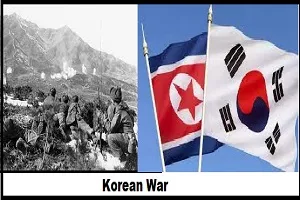The Korean War, which took place between 1950 and 1953, stands as one of the bloodiest and most complex conflicts in modern history. It fractured the Korean Peninsula into two opposing factions: North Korea, supported by the Soviet Union and China, and South Korea, backed by the United States and the UN.
Background
Post-World War II, Korea, once a Japanese colony, was divided into two: North Korea under communist rule led by Kim Il-sung, and South Korea under a pro-Western government led by Syngman Rhee. Tensions between the two Koreas escalated, with minor incidents leading towards open conflict.
1. Division of Korea
Post-World War II, Korea was divided into two: North Korea (communist) under Kim Il-sung, and South Korea (pro-Western) under Syngman Rhee.
2. Tensions and Incidents
Tensions between the two Koreas escalated over time, with a series of minor incidents triggering conflict escalation.
Triggering the War
1. Invasion of South Korea
On June 25, 1950, North Korea invaded South Korea, sparking armed conflict.
2. International Response
The United Nations (UN) swiftly supported South Korea and dispatched foreign troops to repel North Korea.
Phases of Conflict
1. Initial Warfare
North Korea rapidly captured South Korean territory, including the city of Seoul.
2. UN Counteroffensive
UN forces, primarily from the United States, launched a counter-offensive to push back North Korea.
3. Chinese Intervention
China intervened at this stage, sending troops to aid North Korea.
War and Armistice
1. Fierce Battles
The conflict escalated into fierce battles along the frontlines, with guerrilla tactics being common.
2. Armistice
After three years of fighting, an armistice was announced on July 27, 1953, marking the end of physical combat.
Triggering the War
On June 25, 1950, North Korea launched a massive invasion of South Korea, swiftly capturing Seoul within days. North Korea aimed to reunify Korea under communist rule. International response came swiftly, with the United Nations (UN) supporting South Korea and calling for the dispatch of foreign troops to repel the North Korean aggression.
Foreign Interventions
Foreign intervention became a hallmark of the Korean War. UN forces, predominantly composed of US troops, fought alongside South Korean forces against North Korea. On the other side, China intervened on behalf of North Korea, deploying forces to combat UN troops. This complicated the conflict, turning it into a battleground between Western globalist interests and Eastern communist power.
Guerrilla Warfare and Tactics
The Korean War was not solely about open conflict. Often, battles were fought in the form of guerrilla warfare and deceptive tactics. This created a highly challenging environment for both sides, with small units able to launch surprise attacks and then vanish into the forests or mountains.
Armistice and Division
After three years of fierce fighting, an armistice was finally announced on July 27, 1953. However, the war was never formally ended, as only an armistice was signed, not a peace agreement. Korea remained divided, with the Demilitarized Zone (DMZ) serving as a harsh dividing line between the two Koreas.
Impact and Legacy
The Korean War left deep scars. Over two million lives were lost, including many civilians. Furthermore, Korean infrastructure lay in ruins, and civilian suffering was widespread. The legacy of the Korean War continues to this day, with the Korean Peninsula still in a state of high political tension and uncertainty about its future.
1. Loss of Life and Destruction
Over 2 million lives were lost, and Korean infrastructure suffered severe damage.
2. Korea Divided
The armistice left Korea divided, with the Demilitarized Zone (DMZ) separating the two Koreas.
3. Continued Conflict
Political and social conflict on the Korean Peninsula persists to this day, creating uncertainty and tension.
Facts about the Korean War
- The Korean War lasted from 1950 to 1953, resulting in approximately 2 million civilian casualties.
- It was a proxy war between the communist North Korea, supported by the Soviet Union and China, and the capitalist South Korea, backed by the United States and the UN.
- The war ended with an armistice agreement in 1953, but no formal peace treaty has ever been signed, leaving the two Koreas technically still at war.
- The Korean War introduced new tactics and technologies, including widespread use of helicopters for medical evacuation and reconnaissance.
- The conflict saw significant involvement of foreign troops, with over 1.5 million Chinese soldiers and about 1.8 million UN soldiers, predominantly from the United States, fighting in Korea.
- The Korean War resulted in the division of the Korean Peninsula along the 38th parallel, creating the demilitarized zone (DMZ) that remains heavily fortified to this day.
- It marked the first military action of the Cold War era and set the stage for future tensions in East Asia.
- The war had a profound impact on Korean society, leading to long-lasting trauma and separation of families.
- Despite efforts for reconciliation, the Korean Peninsula remains divided, with North Korea maintaining a totalitarian regime and South Korea becoming a prosperous democracy.
- The Korean War is often referred to as "The Forgotten War" due to its overshadowing by other conflicts like World War II and the Vietnam War.
Conclusion
The Korean War was a bloody conflict reflecting geopolitical tensions and ideological ambitions during the Cold War era. While the armistice halted physical combat, tension on the Korean Peninsula remains high, indicating that the legacy of the war still lingers today.
The Korean War stands as one of the most tragic conflicts in modern history. Apart from being a battlefield between global interests, it also reflects the suffering endured by the Korean people caught between the grand ambitions of world powers. While the armistice halted physical fighting, the political and social conflict on the Korean Peninsula persists to this day, ensuring that the legacy of the war will never be forgotten.




Tidak ada komentar:
Posting Komentar